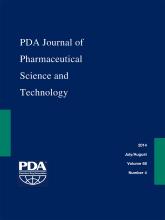Review ArticleReview
Justification for the Use of Aseptic Filling for Sterile Injectable Products
Anthony M. Cundell
PDA Journal of Pharmaceutical Science and Technology July 2014, 68 (4) 323-332; DOI: https://doi.org/10.5731/pdajpst.2014.00988
Anthony M. Cundell
Consulting Microbiologist, Scarsdale, New York, USA

References
- 1.
21 CFR 211.113 (b) Control of Microbiological Contamination.
- 2.↵
- Akers J. E.,
- Agalloco J. P.
- 3.↵
- 4.↵
- Cundell A. M.,
- Fontana A.
- Cundell A. M.
- 5.
EMA Note for Guidance on Development Pharmaceutics CPMP/155/96 2000; Annex Decision Trees for the Selection of Sterilization Methods CPMP/QWP/054/098.
- 6.
Ph. Eur. Methods of Preparation of Sterile Products.
- 7.
FDA Guidance for Industry. Sterile Drug Products Produced by Aseptic Processing—Current Good Manufacturing Practice, 2004.
- 8.
FDA Guideline for the Submission of Documentation for Sterilization Process Validation in Applications for Human and Veterinary Drug Products, 1991.
- 9.
FDA Guidance for Industry. Submission of Documentation in Applications for Parametric Release of Human and Veterinary Drug Products Terminally Sterilized by Moist Heat Processes, 2010.
- 10.↵
- Friedman R. L.
- 11.↵
- Denyer S.,
- Baird R.
- Dewhurst E.,
- Hoxey E. V.
- 12.
ICH Q1A (R2) Stability Testing of New Drug Substances and Products.
- 13.
ICH Q8 (R2) Product Development.
- 14.↵
- Jimenez L.
- 15.
- Mann A.,
- Kiefer M.,
- Leuenberger H.
- 16.↵
- 17.↵
- Murphy T. D.,
- Hokes J.,
- Green T. C.,
- Cundell A. M.
- 18.
- Nayayama A.,
- Yano Y.,
- Kobayashi S.,
- Ischikawa M.,
- Sakai K.
- 19.
PDA Technical Report #36. Current Practices in the Validation of Aseptic Processing, 2001.
- 20.
PDA Technical Report #1 (Revised). Validation of Moist Heat Sterilization Processes: Cycle Design, Development, Qualification and Ongoing Control, 2007.
- 21.
PDA Technical Report #30 (Revised 2012). Parametric Release of Pharmaceuticals Terminally Sterilized by Moist Heat.
- 22.
- Sandle T.
- 23.↵
- Gibson M.
- Steele G.
- 24.↵
- Sutton S.,
- Jimenez L.
- 25.↵
- Thiboutot R. P.
- 26.
USP <1222> Terminally Sterilized Pharmaceutical Products—Parametric Release.
In This Issue
PDA Journal of Pharmaceutical Science and Technology
Vol. 68, Issue 4
July/August 2014
Justification for the Use of Aseptic Filling for Sterile Injectable Products
Anthony M. Cundell
PDA Journal of Pharmaceutical Science and Technology Jul 2014, 68 (4) 323-332; DOI: 10.5731/pdajpst.2014.00988
Jump to section
- Article
- Abstract
- Introduction
- U.S. and European Regulatory Agency Positions on Aseptic Processing Versus Terminal Sterilization
- Product Recalls and Warning Letters
- Categories of Product Generally Not Requiring Justification for Aseptic Processing
- Demonstration of the Heat Instability of a Sterile Drug Product During Pre-formulation
- Sterility Assurance Levels Achieved Using Terminal Sterilization and Aseptic Processing
- Review of Drug Substance and Drug Product Stability As Applicable To Sterile Product Development
- Conclusions
- References
- Figures & Data
- References
- Info & Metrics
Related Articles
- No related articles found.
Cited By...
- No citing articles found.





